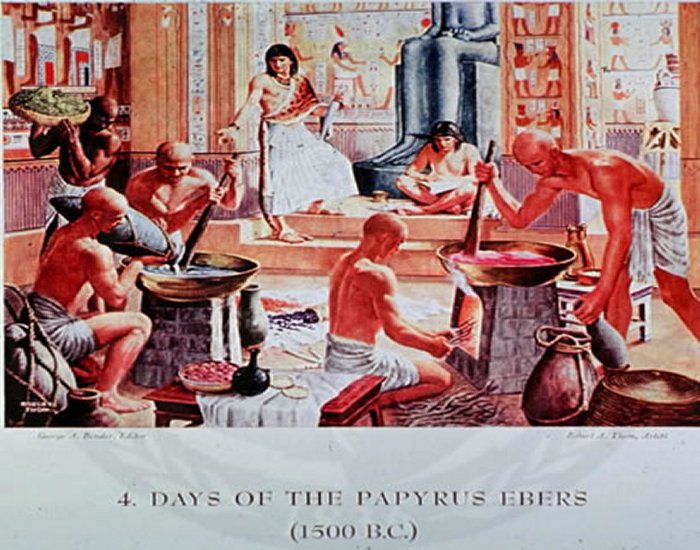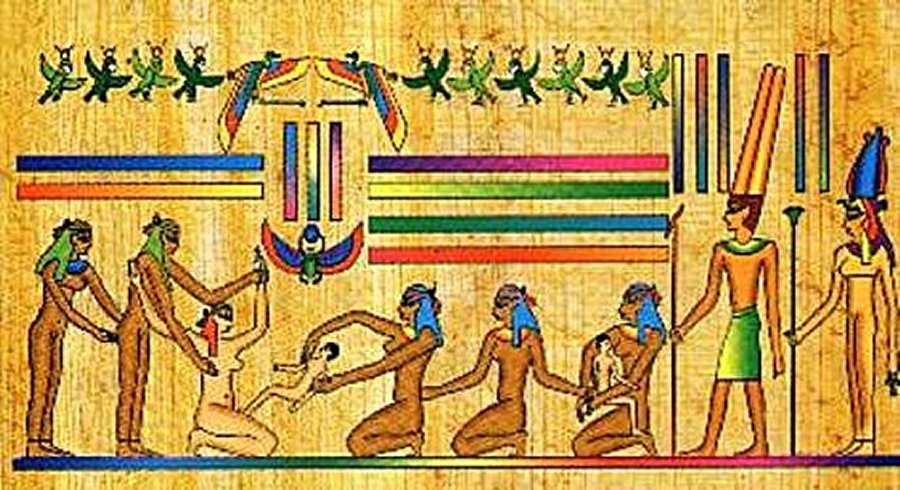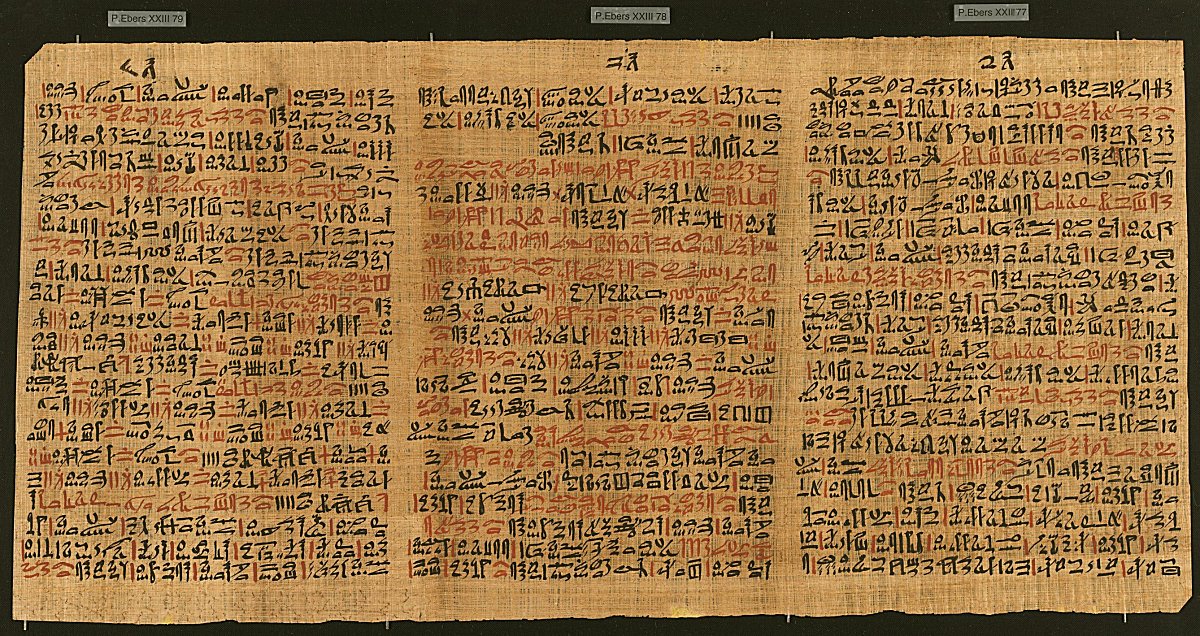The Ebers Papyrus – Most Famous Plant Medicine ‘Encyclopedia’ Of Ancient Egypt
A. Sutherland - AncientPages.com - Herbal medicine was considered complementary medicine in ancient Egypt and it played a key role in society. Ancient Egyptian scrolls document natural herbs and holistic medicine that saved lives and cured disease.
Evidence comes from burial sites, tombs, and underground temples where archeologists have found extensive sets of medical documents and scrolls, including the Ebers Papyrus.
The Ebers Papyrus – the most famous plant – medicine “encyclopedia” – is among several other ancient medical scrolls. A 110-page scroll, which rolls out to be about 20 meters long was found between the legs of a mummy in the Assassif district of the Theben necropolis. Photo: via Naturale clinic
The Ebers Papyrus – the most famous plant – medicine “encyclopedia” – is among several other ancient medical scrolls.
A 110-page scroll, which rolls out to be 20.23 meters in length and 30 centimeters in height, was found between the legs of a mummy in the Assassif district of the Theben necropolis.
It is unclear who the seller was, but the document was purchased in Luxor by Edwin Smith in 1862 and remained in his collection until at least 1869 when there appeared, in the catalog of an antiquities dealer, an advertisement for “a large medical papyrus in the possession of Edwin Smith, an American farmer of Luxor.”
Ten years later, the Papyrus was purchased in 1872 by the Egyptologist George Ebers, for who it is named. In 1875, Ebers published a facsimile with an English-Latin vocabulary and introduction.
This particular reference to the Lower Egyptian Den suggests its origin closer to the First Dynasty (c. 3000 B.C.E.)
The Ebers Papyrus is by far the most lengthy of the medical papyri and it is dated to the 9th year of the reign of Amenhotep I (c. 1534 B.C.E.).
However, it is believed to have been copied from earlier texts or it could be much older because paragraph 856a states that: “the book of driving wekhedu from all the limbs of a man was found in writings under the two feet of Anubis in Letopolis and was brought to the majesty of the king of Upper and Lower Egypt Den.”(Nunn 1996: 31)
The Ebers Papyrus contains magical spells designed to protect from supernatural intervention on diagnosis and treatment. There is also a large section describing different diseases of the stomach, intestinal parasites, skin and eye diseases and diseases of the anus, and many more.
It describes several treatments and is full of prescribed remedies along with a large list of prescriptions to relieve medical ailments.
Several paragraphs contain remedies that are believed to have been made and used personally by various deities; in paragraph 247, for example, there is a note relating to Isis’ creation of a remedy for an illness in Ra’s head, and the document mentions a specific diagnosis.
Here are some remedies from the ancient Ebers Papyrus scrolls:
Aloe vera was used to alleviate burns, ulcers, skin diseases, and allergies
– Basil was written up as heart medicine
– Balsam Apple (Apple of Jerusalem) was used as a laxative and as a liver stimulant
– Bayberry was prescribed for diarrhea, ulcers, and hemorrhoids
– Caraway soothed digestion and was a breath freshener
– Colchicum (citrullus colocynthus or meadow saffron) soothed rheumatism and reduced swelling
– Dill was recognized for laxative and diuretic properties
– Fenugreek was prescribed for respiratory disorders and to cleanse the stomach and calm the liver and pancreas
– Frankincense was used for throat and larynx infections, and to stop bleeding and vomiting
– Garlic was given to the Hebrew slaves daily to give them vitality and strength for building the pyramids
– Licorice was utilized as a mild laxative, to expel phlegm, and to alleviate chest and respiratory problems
– Onion was taken to prevent colds and to address cardiovascular problems (How did they know?)
– Parsley was prescribed as a diuretic
– Thyme was given as a pain reliever and Tumeric for open wounds
– Poppy was used to relieve insomnia, as an anesthetic, and to kill the pain
– Coriander was taken as a tea for urinary complaints, including cystitis
– Pomegranate root was strained with water and drunk to address “snakes of the belly” (tapeworms). The alkaloids contained in pomegranate paralyzed the worms’ nervous system and they relinquished their hold.
– Persian henna was used against hair loss
The papyrus also covers subjects such as dementia, depression, and contains chapters on the diagnosis of pregnancy, several different gynecological matters, contraception, dentistry, and the surgical treatment of burns, tumors, and bone-setting. There is also described the treatment of migraines.
The Ebers Papyrus is currently kept at the library of the University of Leipzig, in Germany.
Written by – A. Sutherland - AncientPages.com Senior Staff Writer
Copyright © AncientPages.com All rights reserved. This material may not be published, broadcast, rewritten or redistributed in whole or part without the express written permission of AncientPages.com
Expand for referencesMore From Ancient Pages
-
 On This Day In History: Sir Francis Drake Sets Sail On His Round-The-World Voyage – On Dec 13, 1577
News | Dec 13, 2016
On This Day In History: Sir Francis Drake Sets Sail On His Round-The-World Voyage – On Dec 13, 1577
News | Dec 13, 2016 -
 Nebuchadnezzar II – Greatest Ruler Of Ancient Babylonia And Conqueror Of Judah
Featured Stories | Jan 28, 2019
Nebuchadnezzar II – Greatest Ruler Of Ancient Babylonia And Conqueror Of Judah
Featured Stories | Jan 28, 2019 -
 The Opening Of Pandora’s Box May Have Been A Real Event
Myths & Legends | Jun 22, 2021
The Opening Of Pandora’s Box May Have Been A Real Event
Myths & Legends | Jun 22, 2021 -
 What Was The Medieval Shame Flute?
Ancient History Facts | Jan 27, 2020
What Was The Medieval Shame Flute?
Ancient History Facts | Jan 27, 2020 -
 Ancient Greco-Roman Amphora Workshop Discovered In Alexandria, Egypt
Archaeology | Apr 17, 2022
Ancient Greco-Roman Amphora Workshop Discovered In Alexandria, Egypt
Archaeology | Apr 17, 2022 -
 What Is The History Of Pancakes?
Ancient History Facts | Mar 7, 2024
What Is The History Of Pancakes?
Ancient History Facts | Mar 7, 2024 -
 A 200-Year-Old Swedish Mystery Remains Unsolved
Ancient Mysteries | Oct 7, 2015
A 200-Year-Old Swedish Mystery Remains Unsolved
Ancient Mysteries | Oct 7, 2015 -
 Top 10 Archaeological Discoveries 2023
Archaeology | Dec 27, 2023
Top 10 Archaeological Discoveries 2023
Archaeology | Dec 27, 2023 -
 1,300-Year-Old Church Discovered Near Mt. Tabor In Lower Galilee, Israel
Archaeology | Jul 28, 2020
1,300-Year-Old Church Discovered Near Mt. Tabor In Lower Galilee, Israel
Archaeology | Jul 28, 2020 -
 On This Day In History: Great Sheffield Flood – Largest Man-Made Disaster Occurred In England – On Mar 11, 1864
News | Mar 11, 2017
On This Day In History: Great Sheffield Flood – Largest Man-Made Disaster Occurred In England – On Mar 11, 1864
News | Mar 11, 2017 -
 King David-Era Fort Unearthed In Golan Heights Sheds Light On Aramean Kingdom Of Geshur
Archaeology | Nov 14, 2020
King David-Era Fort Unearthed In Golan Heights Sheds Light On Aramean Kingdom Of Geshur
Archaeology | Nov 14, 2020 -
 On This Day In History: Famous Inventor Thomas Edison Died – On Oct 18, 1931
News | Oct 18, 2016
On This Day In History: Famous Inventor Thomas Edison Died – On Oct 18, 1931
News | Oct 18, 2016 -
 Where Does The Expression ‘Saved By A Bell’ Come From?
Ancient History Facts | Oct 16, 2019
Where Does The Expression ‘Saved By A Bell’ Come From?
Ancient History Facts | Oct 16, 2019 -
 Unique Tomb Of Roman Noblewoman Caecilia Metella Reveals Secrets Of Ancient Concrete Resilience
Archaeology | Oct 14, 2021
Unique Tomb Of Roman Noblewoman Caecilia Metella Reveals Secrets Of Ancient Concrete Resilience
Archaeology | Oct 14, 2021 -
 Edøy Discovery: Traces Of 1,000-Year-Old Ship Burial Detected In Norway
Archaeology | Nov 24, 2019
Edøy Discovery: Traces Of 1,000-Year-Old Ship Burial Detected In Norway
Archaeology | Nov 24, 2019 -
 2,000-Year-Old Aramaic Inscription Unearthed Near Jerusalem
Archaeology | Oct 24, 2018
2,000-Year-Old Aramaic Inscription Unearthed Near Jerusalem
Archaeology | Oct 24, 2018 -
 Scientists Unravel The Mystery Of The Alexander Sawney Bean Legend & Cave-Dwelling Cannibals In Scotland
Myths & Legends | Sep 24, 2015
Scientists Unravel The Mystery Of The Alexander Sawney Bean Legend & Cave-Dwelling Cannibals In Scotland
Myths & Legends | Sep 24, 2015 -
 Never-Before-Seen Roman-Era Wall Paintings Discovered In Ashkelon Revealed To The Public For The First Time
Archaeology | Aug 30, 2024
Never-Before-Seen Roman-Era Wall Paintings Discovered In Ashkelon Revealed To The Public For The First Time
Archaeology | Aug 30, 2024 -
 Sensational Discovery: 300,000-Year-Old Snapshot – Oldest Human Footprints From Germany Found
Fossils | May 12, 2023
Sensational Discovery: 300,000-Year-Old Snapshot – Oldest Human Footprints From Germany Found
Fossils | May 12, 2023 -
 Nebiri, a ‘Chief of Stables’ – oldest case of heart disease in 3,500-year-old mummy
News | Aug 28, 2015
Nebiri, a ‘Chief of Stables’ – oldest case of heart disease in 3,500-year-old mummy
News | Aug 28, 2015



